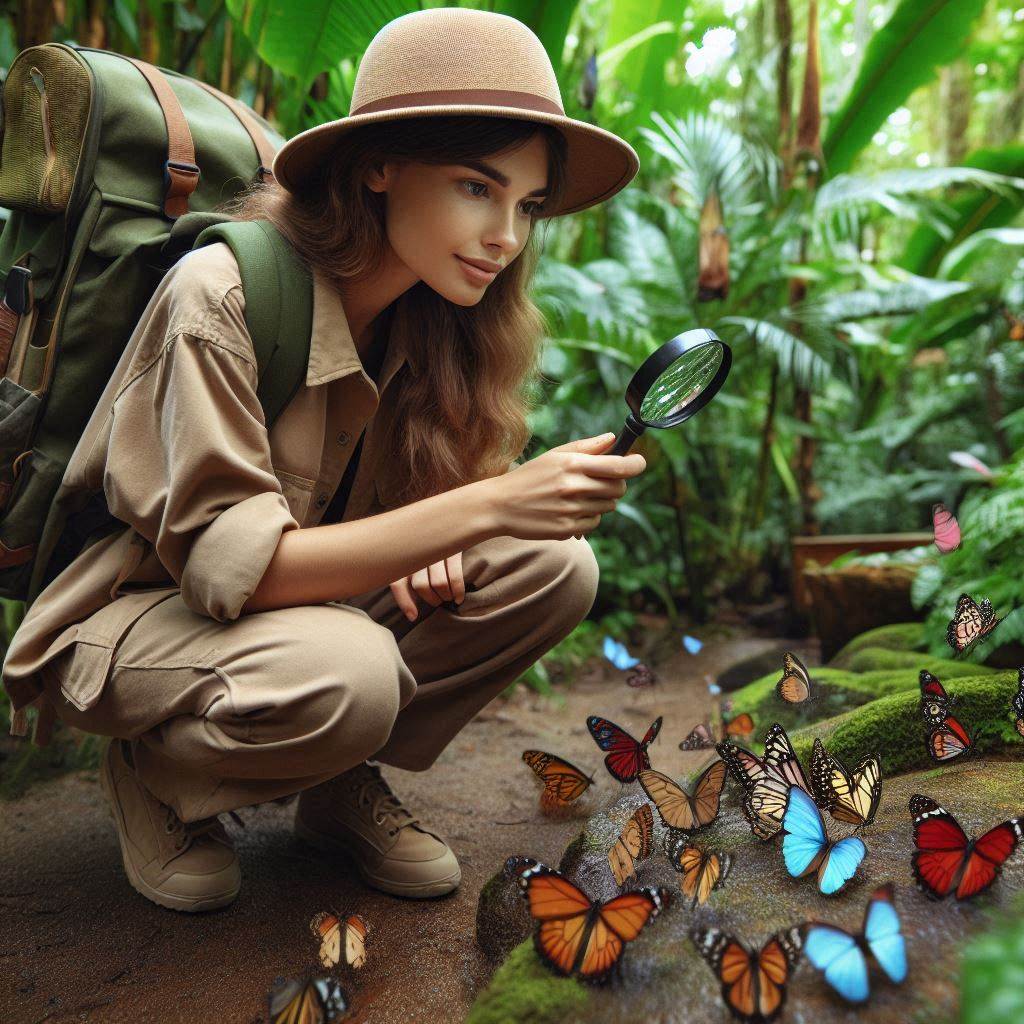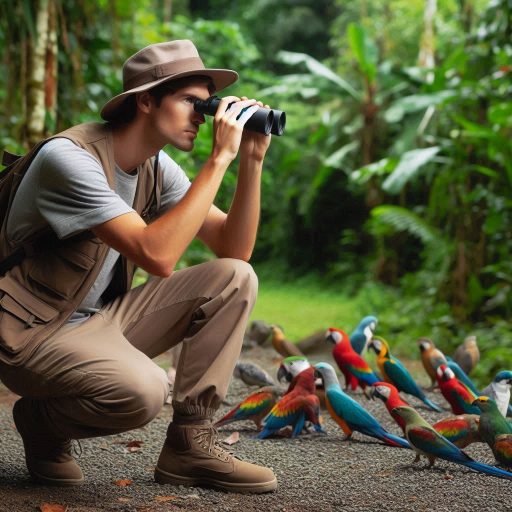Introduction
Animal behavior studies explore how animals interact with one another and their environments, revealing the intricate dynamics of life in the natural world.
This field of research encompasses a wide range of behaviors, from mating rituals and feeding habits to social structures and communication methods.
By examining these behaviors, scientists gain valuable insights into the instincts, learning processes, and adaptations that enable animals to thrive in their specific habitats.
Understanding animal behavior is crucial for several reasons.
It helps us comprehend the evolutionary processes that shape species, the ecological roles they play, and their responses to environmental changes.
Zoologists play a vital role in the study of animal behavior.
Their extensive training and expertise allow them to observe and analyze the complexities of animal interactions in various ecosystems.
By conducting field studies and laboratory experiments, zoologists can gather data on how animals behave in their natural habitats and under controlled conditions.
Insights from zoologists contribute significantly to our knowledge of behavioral ecology, a branch of science that examines the evolutionary basis of behavior in relation to ecological challenges.
For example, studying the foraging behavior of different species can reveal how they adapt to competition for resources.
Overview of Animal Behavior Studies
Definition and Scope of Animal Behavior Studies
Animal behavior studies focus on understanding how animals interact with their environment, other species, and themselves.
This field, known as ethology, investigates a broad range of topics, including communication, mating rituals, foraging strategies, and social structures.
By observing and analyzing these behaviors, researchers gain insights into the complex lives of animals.
This knowledge helps inform conservation efforts, animal welfare, and ecological management.
Ethologists study both instinctual and learned behaviors, examining the influence of environmental factors on animal actions.
Researchers aim to understand how behaviors evolve and their effects on survival and reproduction.
The scope of animal behavior studies includes both wild and domesticated species, covering various habitats and ecological contexts.
Common Research Methods Used in Studying Animal Behavior
Common research methods in animal behavior studies vary widely.
Ethologists often employ observational studies, where they watch animals in their natural settings.
This method allows researchers to gather qualitative data on behavior without interfering with the subjects.
Direct observation helps scientists identify behavioral patterns and social interactions.
Experiments play a crucial role in studying animal behavior.
Researchers design controlled experiments to test specific hypotheses about behavior.
For example, they may manipulate environmental conditions to observe changes in foraging behavior or social interactions.
These experiments provide quantitative data, allowing for statistical analysis and robust conclusions.
Field studies are another important method used in animal behavior research.
These studies take place in the animals’ natural habitats, providing context for behaviors observed.
Field studies often involve long-term monitoring of specific populations, allowing researchers to track changes over time.
This method provides insights into how animals adapt to environmental changes and challenges.
In addition to observational and experimental methods, researchers often use technology to enhance their studies.
For instance, camera traps and GPS tracking devices allow scientists to gather data on animal movements and behaviors without direct observation.
This technology provides valuable information on elusive or endangered species.
Behavioral tests in controlled settings also help researchers understand specific cognitive and social behaviors.
For example, researchers may use mazes or problem-solving tasks to assess learning and memory in animals.
These tests provide a clearer picture of an animal’s cognitive abilities and problem-solving skills.
Animal behavior studies encompass a wide range of methods and topics.
Ethologists utilize observational studies, controlled experiments, field studies, and technology to gather data.
By exploring the intricacies of animal behavior, researchers contribute to our understanding of ecology, conservation, and animal welfare.
The insights gained from these studies are vital for protecting wildlife and promoting sustainable interactions between humans and animals.
Read: Interdisciplinary Research: Botany and Other Sciences
Role of Zoologists in Studying Animal Behavior
Expertise and Training of Zoologists in Observing and Interpreting Animal Behavior
Zoologists play a critical role in studying animal behavior.
Their expertise stems from extensive training in biology, ecology, and behavioral science.
Most zoologists hold advanced degrees in these fields, providing them with a solid foundation for understanding complex animal behaviors.
They learn to observe, analyze, and interpret behaviors in various species, enhancing their research capabilities.
Training programs for zoologists often include hands-on experience in both laboratory and field settings.
This practical training equips them to conduct observational studies and controlled experiments.
Zoologists develop skills in data collection, statistical analysis, and ethical considerations when working with animals.
Their background allows them to recognize subtle behavioral patterns that might be overlooked by untrained observers.
Zoologists also collaborate with other scientists and researchers, broadening their knowledge and understanding of animal behavior.
These collaborations foster interdisciplinary approaches, combining insights from genetics, neuroscience, and ecology.
As a result, zoologists can analyze behaviors within the context of evolutionary adaptations and environmental pressures.
Importance of Zoologists’ Contributions to the Field of Animal Behavior Studies
Zoologists significantly contribute to the field of animal behavior studies through their research and expertise.
Their work helps illuminate the intricate relationships between behavior and ecology, informing conservation efforts and animal welfare practices.
By studying behaviors in natural environments, zoologists provide valuable insights into how animals adapt to changing conditions.
Their research also aids in understanding social structures and communication within animal groups.
For instance, studies on mating rituals and territorial behaviors reveal crucial information about reproductive success and species survival.
Zoologists‘ findings help conservationists design effective strategies for protecting endangered species and preserving their habitats.
Additionally, zoologists contribute to education and public awareness about animal behavior.
They often share their knowledge through publications, lectures, and outreach programs.
This dissemination of information raises awareness of the importance of animal behavior research and fosters appreciation for wildlife.
Zoologists also play a vital role in developing ethical standards for animal research.
They advocate for humane treatment and welfare considerations, ensuring that research practices adhere to ethical guidelines.
Their commitment to ethical behavior enhances the integrity of the field and promotes responsible research practices.
Zoologists are essential to studying animal behavior due to their expertise and training.
Their contributions enrich our understanding of animal behaviors and their ecological implications.
By combining research, education, and ethical advocacy, zoologists significantly advance the field of animal behavior studies.
Their work ultimately benefits wildlife conservation and enhances our appreciation of the natural world.
Read: Women in Botany: Celebrating Pioneers and Leaders
Insights from Zoologists on Communication Behaviors
Examples of How Zoologists Have Studied and Interpreted Animal Communication
Zoologists have conducted extensive research on animal communication, revealing fascinating insights into how animals convey information.
One notable example is the study of vocalizations in birds.
Researchers have observed and recorded different calls and songs, analyzing their meanings in social interactions.
For instance, studies on songbirds demonstrate that males use specific songs to attract mates and establish territory.
Zoologists interpret variations in these vocalizations as indicators of individual fitness and social status.
Another example involves the communication behaviors of primates.
Zoologists have studied vocal calls, facial expressions, and body language among various primate species.
For instance, research on vervet monkeys shows that they use distinct alarm calls to signal different types of predators.
These calls prompt specific responses within the group, highlighting the complexity of their communication system.
By interpreting these signals, zoologists uncover the evolutionary advantages of such behaviors in enhancing survival.
Zoologists also investigate the chemical communication of animals, such as pheromones in insects.
For example, studies on ants demonstrate how they use pheromones to mark trails and signal alarm.
Researchers have identified the chemical compounds involved and explored how ants interpret these signals within their colonies.
This research reveals the sophisticated nature of chemical communication and its role in maintaining social structures.
Understanding the Significance of Communication in Social Behavior Among Animals
Understanding communication is crucial for comprehending social behavior among animals.
Communication facilitates social bonding, coordination, and cooperation within groups.
For instance, many species rely on vocalizations and body language to establish hierarchies and strengthen social ties.
In wolf packs, for example, vocalizations such as howls help coordinate group movements during hunts.
These interactions underscore the importance of communication in maintaining social cohesion.
Communication also plays a vital role in mating behaviors.
Many animals use specific signals to attract potential mates.
Brightly colored plumage in birds often serves as a visual signal of fitness.
Zoologists study these displays to understand how they influence mate selection and reproductive success.
This research sheds light on the evolutionary pressures shaping communication behaviors in various species.
Additionally, effective communication can enhance survival in social species.
Animals that can alert their peers to danger or share information about food sources have a better chance of thriving.
For instance, studies on meerkats show that they use vocal alarms to warn group members of approaching predators.
This collective response improves the overall safety of the group.
Zoologists emphasize the intricate relationship between communication and social behavior.
By studying these dynamics, they provide insights into the evolutionary adaptations that shape interactions within species.
Understanding animal communication helps inform conservation strategies, as it highlights the importance of preserving social structures within animal populations.
Zoologists offer valuable insights into animal communication behaviors through their research and interpretations.
Their studies reveal the significance of communication in social behavior, mate selection, and survival strategies.
By exploring these aspects, zoologists enhance our understanding of the complex lives of animals and contribute to wildlife conservation efforts.
Read: How Climate Change Is Impacting Plant Research

Insights from Zoologists on Mating Behaviors
Examination of Mating Rituals and Strategies Observed by Zoologists
Zoologists have meticulously documented and analyzed various mating rituals and strategies across numerous animal species.
One of the most well-known examples is the elaborate courtship displays of birds.
Many male birds, such as peacocks, perform intricate dances and display their vibrant plumage to attract females.
Zoologists study these behaviors to understand how visual signals impact female mate choice.
Research shows that females often prefer males with more elaborate displays, indicating genetic fitness.
In addition to visual displays, vocalizations also play a significant role in mating behaviors.
For instance, songbirds often engage in singing contests during the breeding season.
Males compete to produce the most appealing songs, which females assess before making their mating decisions.
Zoologists analyze these songs, noting variations in pitch, complexity, and frequency.
Their findings reveal how vocal traits can signal health and vitality, influencing female preferences.
Zoologists also examine mating strategies in species with different reproductive strategies.
For example, in some species of frogs, males call to attract females to breeding sites.
Researchers have noted that the timing and intensity of these calls can affect mating success.
Some male frogs may adopt alternative strategies, such as “sneaking” into breeding sites to compete with larger, more dominant males.
These observations provide insights into the diverse strategies animals use to maximize reproductive success.
Discussion on the Evolutionary Significance of Mating Behaviors in Different Animal Species
The evolutionary significance of mating behaviors is a central focus in zoology.
Mating behaviors often reflect adaptations that enhance reproductive success and ensure the continuation of species.
One key concept in understanding these behaviors is sexual selection, which drives the evolution of traits that improve an individual’s chances of mating.
In many species, females play a crucial role in mate selection.
This selective pressure influences the evolution of male traits and behaviors.
For instance, in the case of bowerbirds, males build elaborate structures called bowers to attract females.
Zoologists study these bowers, noting that more intricate designs often lead to higher mating success.
This phenomenon illustrates how female preferences shape male traits over generations.
Mating behaviors also contribute to genetic diversity within populations.
By promoting interactions between different individuals, these behaviors enhance the mixing of genetic material.
This genetic diversity is vital for the adaptability and resilience of species in changing environments.
Additionally, zoologists explore the role of environmental factors in shaping mating behaviors.
For instance, seasonal changes can influence the timing and nature of mating activities.
In some species, mating rituals may become more pronounced during specific seasons, driven by hormonal changes and resource availability.
Understanding these dynamics helps zoologists assess the impact of environmental changes on reproductive success.
Zoologists provide valuable insights into mating behaviors through their examinations of rituals and strategies.
Their research highlights the evolutionary significance of these behaviors in shaping species survival and adaptability.
By understanding mating behaviors, zoologists contribute to broader discussions on biodiversity, conservation, and the evolutionary processes that drive animal behavior.
Read: Exploring the Different Branches of Geology
Find Out More: Global Nuclear Science Collaborations
Insights from Zoologists on Foraging Behaviors
Research Findings on Foraging Behaviors and Food Acquisition Strategies in Animals
Zoologists have conducted extensive research on foraging behaviors, revealing various strategies that animals use to acquire food.
One notable finding involves the foraging techniques of different bird species.
For instance, studies on woodpeckers have shown that they use their strong beaks to excavate bark and access insects hidden within trees.
This behavior highlights the specialized adaptations that enable woodpeckers to thrive in specific environments.
Another area of research focuses on the foraging behaviors of social insects, such as ants and bees.
Zoologists have documented how these insects communicate about food sources through pheromones.
For example, when a foraging ant finds food, it releases pheromones to create a trail for others to follow.
This cooperative behavior maximizes food acquisition and efficiency within the colony.
Zoologists also study the foraging strategies of mammals, such as wolves and dolphins.
Wolves hunt in packs, using coordinated strategies to capture prey.
Researchers have observed that pack members often take turns chasing and cornering prey, increasing their chances of success.
Similarly, studies on dolphins reveal their use of unique foraging techniques, such as “bubble-net feeding.
” This method involves creating a circle of bubbles to trap fish, showcasing the cognitive abilities of these animals.
In addition to observational studies, zoologists use experiments to understand the factors influencing foraging decisions.
For example, they may manipulate food availability to observe how animals adjust their foraging patterns.
These experiments provide insights into the decision-making processes that govern food acquisition strategies.
Implications of Foraging Behaviors on Animal Survival and Adaptation
Foraging behaviors have significant implications for animal survival and adaptation.
Efficient foraging directly affects an animal’s ability to obtain energy, reproduce, and thrive in its environment.
Animals that can quickly locate and acquire food are more likely to survive and reproduce successfully.
Foraging behaviors also influence how animals interact with their environments.
For example, some species adapt their foraging strategies based on seasonal changes in food availability.
In many bird species, researchers have observed shifts in diet and foraging techniques during different seasons.
These adaptations demonstrate the flexibility of foraging behaviors in response to environmental changes.
Additionally, foraging behaviors contribute to the overall ecological balance.
Animals that forage effectively help regulate prey populations and maintain healthy ecosystems.
For instance, predators like hawks and foxes play crucial roles in controlling populations of small mammals.
This balance is vital for the health of their habitats.
Furthermore, foraging behaviors can serve as indicators of environmental health.
Zoologists study how changes in food availability impact animal behaviors and populations.
If animals struggle to find food due to habitat loss or pollution, their foraging behaviors may change.
Such changes can signal underlying ecological issues, prompting conservation efforts.
Zoologists provide valuable insights into foraging behaviors and their implications for animal survival.
Their research highlights the diverse strategies animals use to acquire food and adapt to changing environments.
By understanding foraging behaviors, zoologists contribute to broader discussions on ecology, conservation, and the importance of preserving habitats that support diverse wildlife.
Uncover the Details: Job Market and Career Opportunities for Zoologists
Case Studies of Animal Behavior Studies Conducted by Zoologists
Highlighting Specific Research Projects and Their Findings
Zoologists have conducted numerous influential studies that have advanced our understanding of animal behavior.
One notable case study involves the research on killer whales (orcas) conducted by Dr. Hal Whitehead.
His long-term study focused on the social structures and vocal behaviors of these highly intelligent marine mammals.
Dr. Whitehead discovered that orca pods have unique dialects, with vocalizations varying significantly between different groups.
This finding emphasizes the importance of social learning in animal communication and the complexity of orca social networks.
Another significant case study examined the foraging behaviors of New Caledonian crows.
Researchers led by Dr. Gavin Hunt observed these crows using tools to extract insects from tree bark.
They discovered that these crows can create and use tools, a behavior previously thought to be unique to primates.
This study revealed the cognitive abilities of these birds, highlighting their problem-solving skills and adaptability.
The research has contributed to our understanding of animal intelligence and its evolutionary implications.
A third case study involved the mating behaviors of red-collared widowbirds.
Zoologist Dr. Anders Pape M‘ller studied how male widowbirds use elaborate tail feathers to attract females.
His findings demonstrated that longer tails correlated with higher mating success, illustrating the role of sexual selection in shaping physical traits.
This research has provided valuable insights into the evolutionary pressures that influence mating behaviors in birds.
Discussing the Impact of These Studies on the Field of Animal Behavior Studies
These case studies have significantly impacted the field of animal behavior studies, influencing both research methodologies and theoretical frameworks.
The work on orca communication has paved the way for further studies on marine animal social structures, highlighting the importance of long-term observational research in understanding complex behaviors.
This study encourages researchers to consider social dynamics and communication patterns when studying other species.
The research on New Caledonian crows has challenged traditional views of intelligence in the animal kingdom.
By demonstrating that tool use is not limited to primates, this study has prompted zoologists to explore cognitive abilities across various species.
It has inspired new research into the evolutionary origins of tool use and problem-solving skills in animals, leading to a broader understanding of intelligence in the animal world.
The findings on red-collared widowbirds have reinforced the significance of sexual selection in evolutionary biology.
This research has contributed to the ongoing debate about the relative roles of natural and sexual selection in shaping animal behaviors and physical traits.
As a result, it has encouraged further exploration of the intricate relationship between mating behaviors and evolutionary pressures across species.
Case studies conducted by zoologists have provided valuable insights into animal behavior and its evolutionary significance.
These studies have advanced our understanding of communication, intelligence, and mating behaviors while shaping future research directions in the field.
By highlighting the complexities of animal behavior, these case studies continue to inspire scientists and foster a deeper appreciation for the diversity of life on our planet.
Conclusion
Insights from zoologists play a crucial role in understanding animal behavior.
Their research enhances our knowledge of how animals interact with their environments.
By studying various species, zoologists uncover behavioral patterns essential for conservation efforts.
This knowledge informs policies that protect endangered species and their habitats.
Understanding animal behavior can lead to more effective management strategies and educational programs for the public.
Collaboration between zoologists and other scientists is vital for advancing research in animal behavior.
Interdisciplinary partnerships can lead to innovative methods and solutions.
For example, combining genetics and ethology can deepen our understanding of behavioral traits.
Similarly, integrating ecology and psychology can provide insights into how animals adapt to changing environments.
Encouraging further research will foster a more comprehensive view of animal interactions.
As we deepen our understanding, we can better appreciate the complexity of animal lives.
Promoting these collaborations will benefit not only science but also wildlife conservation efforts.
By working together, scientists can unlock new insights into the fascinating world of animal behavior.
These insights will ultimately guide efforts to preserve biodiversity and protect our planet‘s natural ecosystems.
Transform Your Career Today
Unlock a personalized career strategy that drives real results. Get tailored advice and a roadmap designed just for you.
Start Now[E-Books for Sale]
The Big Book of 500 High-Paying Jobs in America: Unlock Your Earning Potential
$19.99 • 500 High-Paying Jobs • 330 pages
Explore 500 high-paying jobs in America and learn how to boost your career, earn more, and achieve success!
See All 500 High-Paying Jobs of this E-Book
1001 Professions Without a Degree: High-Paying American Jobs You Can Start Now
$19.99 • 1001 Professions Without a Degree • 174 pages
Discover 1001 high-paying jobs without a degree! Unlock career tips, skills, and success strategies for just $19.99!




